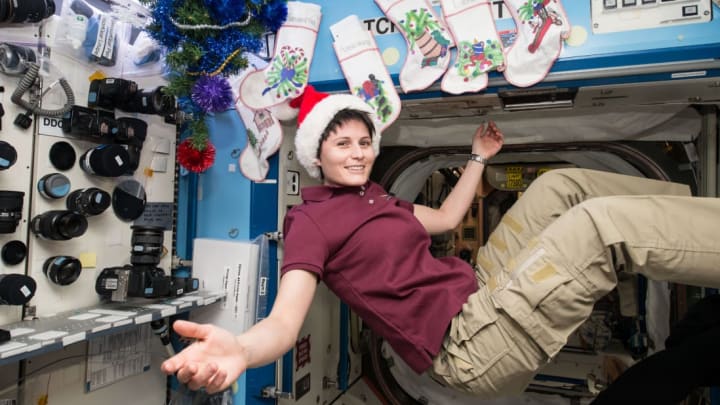On December 25, 1968, the staff of mission control at NASA received confirmation of a long-rumored and hotly debated phenomenon. Over the crackle of a transmission coming from space on Christmas morning, astronaut Jim Lovell disclosed what must have been one of the most closely-kept space secrets of the entire program:
“Roger, please be informed there is a Santa Claus.”
Misers may doubt the veracity of Lovell’s eyewitness account of a corpulent bearer of space gifts, but the message was a fitting one. The voyage of Apollo 8 to circle the moon marked the first time astronauts had spent the holiday outside the confines of Earth. That milestone was due in large part to the efforts of John F. Kennedy, the late president who had vowed that America would be the first country to land on the moon—and that we'd do it before the end of the decade. As the 1960s drew to a close, NASA was still struggling with the Apollo lunar module that would allow astronauts to touch down on the moon’s surface. They opted to send the crew of the Apollo 8—Lovell, Frank Borman, and Bill Anders—to orbit the moon instead.
The timing of the mission provided an additional sense of romanticism to the space program. In addition to taking the famous "Earthrise" photo that offered a glimpse of the planet from a new perspective, the crew orbited the moon 10 times on Christmas Eve. The astronauts were then asked to communicate a message that would be broadcast to over 1 billion people over the radio and on television. NASA left the particulars up to them.
The men decided to read from the Book of Genesis, taking turns reciting the first 10 verses. They concluded by offering what may well have been the first holiday goodwill message ever directed at Earth from outer space, wishing everyone “on the good Earth” a pleasant season. They splashed down in the Pacific Ocean on December 27.
Over the next several decades, the idea of a space Christmas has frequently intersected with terrestrial celebrations. The next crew to spend the holiday among the stars was the team on Skylab 4, which observed the holiday in 1973. Gerald Carr, William Pogue, and Edward Gibson decided to craft a Christmas tree out of food cans and packing material. On Christmas Day, Carr and Pogue performed what was then the longest spacewalk recorded outside of Earth’s orbit—a total of seven hours and one minute. (Soviet cosmonauts were also in orbit aboard the Soyuz 13, but tracking their holiday festivities is trickier, as Russia typically uses the Julian calendar and observes Christmas on January 7.)
No American had an overlapping space mission with Christmas again until 1996, when John Blaha was on board Russia’s Mir space station. Blaha and the crew received a delivery from the Progress spacecraft, which was full of presents, cards, and food. “It was a shining star, rising toward us at great speed from beneath the horizon,” Blaha later recalled of the Progress. “All of a sudden, the light from the Progress extinguished as we passed into the shade of the Earth. Five seconds later, four lights on the Progress were turned on. I watched the remainder of the rendezvous through a tiny window in the aft end of the Kvant module.”
Opening the packages from Progress, he added, was “like Christmas and your birthday, all rolled together, when you are 5 years old.” What might become routine to Earthbound observers took on a new and special meaning in the vastness of space.
In 1999, Michael Foale spent the first of two holidays in space with the STS-103, the first shuttle mission to fly during the holiday. The crew was awakened to the sounds of Bing Crosby’s “I’ll Be Home for Christmas” on Christmas Day. Then, Foale and his colleagues on the Space Shuttle Discovery deployed the long-dormant Hubble Space Telescope, which had been inoperable since losing its fourth gyroscope and had been repaired by the crew. After they were done, Foale and his international partners from France and Switzerland sent holiday greetings in different languages.
Later, as members of the International Space Station began longer tenures in space, Christmas became more of a regular observation. The Expedition One crew was the first on the ISS to celebrate in 2000. American Bill Shepherd and Russian cosmonauts Yuri Gidzenko and Sergei Krikalev opened gift-wrapped presents courtesy of the Progress and chatted with their respective families.
Expedition 4 on the ISS did something similar, but also had turkey and other traditional menu items on hand in addition to regular space food.
In December 2018, the crew of Expedition 58 got a delivery of gifts courtesy of the SpaceX Dragon CRS-16 cargo spacecraft. (They also showed off an Elf on a Shelf.) In December 2019, the crew of Expedition 61 appeared in a video message sporting caps, stockings, and a promise to turn the lights down low to enjoy some Christmas movies. Time will tell how the recently-organized United States Space Force will observe the holidays.
Naturally, Christmas isn’t the only seasonal celebration to be observed outside of Earth, though sometimes the blue planet can still get involved. Astronaut Scott Kelly, who spent several holidays aboard the ISS, told National Geographic in 2017 that New Year’s Day is a little more exciting on the ISS because more nations celebrate it. Looking down, Kelly said, he could see little dots of light on Earth. They were fireworks.
While the historic celebrations of Apollo 8 and those that followed were generally well-received, not everyone was seized with holiday spirit. After Lovell and company recited passages from the Bible, NASA was sued by an atheist named Madalyn Murray O'Hair on the premise that her First Amendment rights had been violated. The suit was dismissed, but perhaps O'Hair's actions were unavoidable. Every good holiday story needs its Scrooge.
